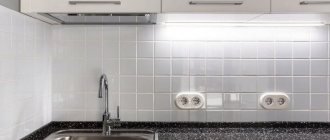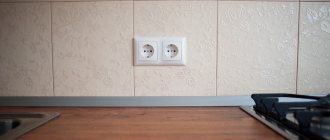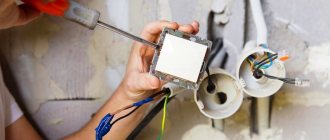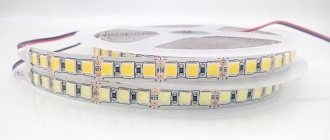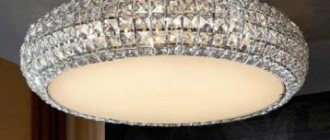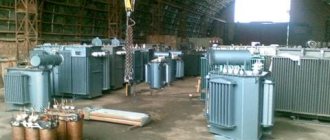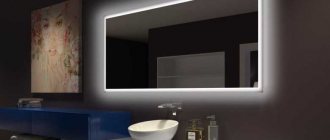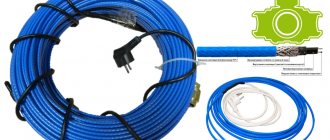Practice shows that the wiring in the kitchen, in terms of its complexity and the loads experienced, is fundamentally different from similar wiring in the rest of the rooms of an apartment or private house. It is necessary to take into account the specifics of this room.
It often houses a large number of powerful electrical appliances, including an electric oven, hob, kettle, microwave, heated floors, air conditioning, washing machine and dishwasher. Moreover, the purchase of each new device creates additional load on the network. All these points must be taken into account when designing electrical wiring.
Features of providing kitchen electricity
The presence of high-power household appliances (kettle, hob, air conditioner, extractor hood, dishwasher) makes the kitchen a room characterized by maximum electrical energy consumption. For this reason, you cannot get by in a room with only 2-3 sockets and one switch.
A kitchen wiring diagram that involves installing only one junction box is often ineffective. It will not cope with the load when all kitchen appliances are turned on.
For the wiring to function properly, you must adhere to the following rules:
- Electrical appliances that have high power are supplied with a separate line and their own automatic machine.
- There are different lines for lighting fixtures and sockets. Each branch must be equipped with a separate residual current device.
- Mandatory grounding of outlets. This increases the service life of the network and kitchen appliances.
- When attaching only one junction box (usually in a small kitchen), a three-core cable with a cross-section of 4 mm² is used.
At the preparatory stage, the total power of all devices is calculated and a specific wiring diagram is drawn up. Based on this data, it is determined what type of cable will be laid.
When choosing a cable, take into account the power of each device. Despite this, it is best to install three-wire wiring in the kitchen. If you have a warm electric floor, the wiring diagram may look like this:
- a branch for a chandelier and halogen lighting near the sink or hob;
- line to heated floor;
- branch for appliances with low power (microwave oven, mixer, toaster, food processor);
- separate lines for powerful appliances (oven, dishwasher, hob);
- branch for double socket (for hood and refrigerator).
To install high-quality wiring in the kitchen with your own hands, we will need:
- cable;
- distribution box (or switchboard);
- sockets with socket boxes and switches;
- RCD;
- terminal blocks;
- alabaster and spatula;
- corrugated tubes;
- insulating tape;
- fasteners (screws, dowel-nails and staples);
- screwdrivers, pliers, side cutters, knife;
- perforator;
- Bulgarian;
- indicator;
- level;
- hammer and chisel.
Preparatory work
Before starting work, it is necessary to ensure clear planning of the kitchen wiring installation process. At the preparation stage, before installing wiring in the kitchen, you should do the following:
- Cleaning the room - remove from the room all old furniture and equipment that will interfere;
- Remove wallpaper or other wall coverings that may interfere with planning;
- Determine the condition of the old wiring (if you are doing wiring in the kitchen, where it was previously installed);
- Calculate the total load on the wiring from the devices you plan to use;
- Draw up a diagram of future wiring in the kitchen;
- Select the basic parameters of the wiring elements and their quantity required for the operation of kitchen appliances.
Diagnosis of old wiring
Even if you have an old kitchen power line, it should be borne in mind that in Soviet times, and even in the 90s, there was no such abundance of household appliances. Consequently, the old wiring is not designed for modern electrical appliances and their parameters, so it is better to install new wiring.
The old wiring can be disconnected from the power and left in the wall if you are not planning a complete replacement. Otherwise, it is better to dismantle it. To find the location of old wiring, you can use a non-contact indicator. If you are dismantling it, you can remove the old wires from the box as you dismantle it.
Calculations
To determine which sockets, switches, machines, and, most importantly, wires you need, you need to calculate both the total power for all kitchen electrical appliances (for example, you can use Table 1), as well as individual devices and their groups. After compiling a list of power consumption from these devices, you will need to determine the total current that the kitchen can consume as much as possible. Based on it, the wire cross-section is calculated (you can use Table 2 or our calculator), the parameters of protective circuit breakers and connection nodes for new wiring.
Table 1. Average typical power consumption of various household electrical appliances.
| electrical appliance | Average power consumption, kW |
| Fridge | 0,1 |
| Dishwasher | 1 |
| Microwave | 2 |
| Electric kettle | 2 |
| TV | 0,07 |
| Oven | 2,5 |
| Lighting | 0,2 |
| Toaster | 2 |
| Electric grill | 2 |
For example, if one bread machine with a power of 1 kW is connected to the outlet, then for it you can choose a standard 1.3 kW 16 A outlet. The wire for such an outlet should be 1.5 mm2 for copper cables or 2.5 mm2 for aluminum .
If more powerful equipment is connected to the outlet, for example, a 2.3 kW oven, then you should not choose an outlet with a lower rating of 2.2 kW, as it will heat up and eventually melt. It is better to choose a model with a power reserve of 3.5 kW and 16 A.
Please note that if you connect sockets with a cable, you need to add up the power of the devices connected to them. For example, you connect three sockets in series that will power a 2 kW toaster, a 1.5 kW microwave and a 2 kW electric kettle. In this case, you can install the same 10 A or 2.2 kW sockets on each device. But when choosing a conductor cross-section, all powers must be added up: 2 + 1.5 + 2 = 6 kW, then the cable cross-section for powering a group of sockets must be taken at least 4 mm2 for copper or 6 mm2 for aluminum.
Wiring diagram
To draw up a diagram of the wiring in the kitchen, connection nodes and installation of switching equipment, you need to determine where and what devices will be installed. Take into account the arrangement of furniture, refrigerator, washing machine, electric kettle, microwave, kitchen hood, electric or combined stove, and other equipment. Each appliance will have an impact on the wiring in the kitchen.
Rice. 1: determine the installation location of furniture and appliances
When drawing up an electrical network diagram, be guided by the following principles:
- Wire connections should be made exclusively in boxes and electrical elements (sockets, switches, lamps).
- Cable laying is carried out only in horizontal and vertical lines; it is not allowed to reduce the distance diagonally or along an arc to save length.
- Vertical lines are laid at a distance of no closer than 10 cm from door and window openings, corners and other obstacles in this plane; in relation to horizontal lines, it is necessary to maintain 20 cm from the ceiling and 10 cm from the cornice.
- All sockets can be installed at a height of 0.8 - 1 m from the floor according to clause 6.6.30 of the PUE, in some situations the height can be increased to 1.5 m. Also note that sockets cannot be closer than 0.5 m to metal ones pipes, stove bodies, radiators, sinks and other metal parts.
1.1. An example of an electrical wiring diagram in the kitchen If built-in furniture is installed in the kitchen, it is convenient to place some of the sockets above the countertop at a distance of 10 - 20 cm. Those sockets to which the built-in equipment will be connected (stove, washing machine, hood, etc.), it is advisable hide under the countertop.
The kitchen wiring plan must contain the power of the devices according to which the appropriate components are selected. Electrical wiring must take into account the cross-section of wires for each connection node in accordance with their power.
Selection of components
The cross-section of the wiring cores is selected according to the load current of a particular object connected to the outlet or according to the power of the electrical appliance. To do this, you can use Table 2, which shows the correspondence of wire cross-section to load and power.
Table 2. Table of correspondence of wire cross-section to load and power.
| Copper wire | Aluminum wire | |||||
| Section of veins. mm | Current. A | Power. kW | Section of veins. mm | Current. A | Power, kWt | |
| 1.5 | 19 | 4.1 | 2.5 | 22 | 4.4 | |
| 2.5 | 27 | 5.9 | 4 | 28 | 6.1 | |
| 4 | 38 | 8.3 | 6 | 36 | 7.9 | |
| 6 | 46 | 10.1 | 10 | 50 | 11 | |
| 10 | 70 | 15.4 | 16 | 60 | 13.2 | |
| 16 | 80 | 18.7 | 25 | 85 | 18.7 | |
| 25 | 115 | 25.3 | 35 | 100 | 22 | |
| 35 | 135 | 29.7 | 50 | 135 | 29.7 | |
| 50 | 175 | 38.5 | 70 | 165 | 36.3 | |
| 70 | 215 | 47.3 | 95 | 200 | 44 | |
| 95 | 265 | 57.2 | 120 | 230 | 50.6 | |
| 120 | 300 | 66 | ||||
In this case, the safety factor should be taken into account, whether for aluminum or copper wires. As a rule, a reserve of 20–30% is provided in case of surges or increases in the power of devices in the kitchen in the future.
According to the number of wires, the electrical wiring must have at least three wires - for phase, neutral and grounding. Despite the fact that most old houses were not equipped with a grounding loop, and, accordingly, no terminal in the panel, today all electrical wiring diagrams must be equipped with protective grounding. This conductor is connected to the grounding terminals of sockets, metal housings of lamps and connected to an RCD.
To turn on powerful devices (electric ovens, dishwashers, refrigerators, electric stoves, etc.), power outlets must be selected. Which are equipped with more powerful lamellas and can easily withstand the given load (16 A, 32 A). The cross-section of the cable supplied to such sockets is chosen to be much larger than for low-power ones. For low-power devices, groups of sockets or sockets connected by a cable can be used.
The choice of switch for the kitchen is limited only by its functionality and compliance with the interior design.
Home wiring calculator
To begin with, we calculate the power of the machine for all current consumers present and switched on simultaneously. If you have a refrigerator and a computer running, and you also run a washing machine, which requires an instantaneous water heater and a pump to supply water, then the consumption will be about 11 kW. This is even if we exclude lighting. It is logical that a 16 A machine will not withstand such a load. You can see what power these or other devices have in the following table; then, using the above formula, we calculate the rating of the machine.
Power of electrical appliances (W)
| Hair dryer | 1200 | Drill | 800 |
| Iron | 1700 | Hammer | 1200 |
| Electric stove | 3000 | Electric sharpener | 900 |
| Toaster | 800 | Circular Saw | 1300 |
| Coffee maker | 1000 | Electric planer | 900 |
| Heater | 1500 | Jigsaw | 700 |
| Grill | 1400 | Grinder | 1700 |
| Vacuum cleaner | 1600 | Water heater | 5000 |
| Printer | 100 | Washing machine | 2500 |
| TV | 300 | Compressor | 2000 |
| Fridge | 300 | Water pump | 1000 |
| Microwave | 1400 | A circular saw | 2000 |
| Computer | 500 | Air conditioner | 1500 |
| Electric kettle | 1200 | Electric motors | 1500 |
| Full coverage | 1000 | Fans | 1000 |
| Boiler | 1500 | Lawnmower | 1500 |
| Air fryer | 1700 | Welder | 2300 |
| Radio | 70 | Concrete mixer 70 liters | 250 |
| Treatment plant compressor (WTP) | 200 | Infrared heater | 600 |
To install the electrical network, branch boxes are used, from which the wiring is pulled into adjacent rooms.
It should be remembered that when wiring the electrical network around the house, you must immediately divide it into three groups, one of which is allocated entirely for lighting fixtures, the second for sockets, and the third is used for devices that require grounding. This will make it easier to calculate the electrical wiring calculator. In this case, in no case should you use one neutral cable for two different groups, as well as combine them with each other. It is also necessary to provide each individual group with its own automatic protective switch, the rating of which is calculated from the sum of the powers of the devices connected to this wiring.
Connection to electrical panels
To improve overall safety and control of kitchen appliances, modern kitchen networks should be connected to separate electrical panels.
Each of the above groups of electrical appliances, which we divided into before starting work, must be connected to a separate electrical circuit breaker, depending on the total energy consumption and power:
- A group of lighting fixtures is connected to a circuit breaker with a rated operating current of 10 amperes.
- A group of low-power devices, despite the low power consumption of individual devices, collectively produces a fairly large load. Such devices are connected through a 16-25 ampere circuit breaker.
- A group of power electrical appliances is connected to a 25 ampere circuit breaker.
- The electric stove or hob is the most powerful appliance in the entire kitchen, so it is connected to a separate 50-amp circuit breaker.
Total power and cable selection
Regardless of the type of renovation work, installation begins with the planning stage. This also applies to kitchen wiring. Initially, you need to determine the type of network that is installed in the apartment. If the network is three-phase, then everything is just fine, and you will have a decent power reserve. With a single-phase network there are certain limitations. Often three phases are supplied to apartments where an electric stove is used instead of a gas stove.
Next, the power of all kitchen electrical appliances, both existing and planned in the future, is calculated. The calculation is made based on information about the rated power of each individual device. This information can be found in the operating instructions. During the calculations, you should get a power ranging from 8 to 15 kilowatts. This number reflects energy consumption in the case when all consumers are connected to the network, which is relatively rare. At the same time, it is better to have a reserve of power than a lack of it. The picture below shows a table for selecting a suitable cable cross-section depending on the characteristics of the network.
Let's say the total power of electrical appliances in the kitchen is 11 kilowatts, then for wiring it is advisable to use copper wire of the VVG type with a cross-section of 6 millimeters. With a calculated load of 15 kilowatts, you will need a more powerful cable - VVG with a 10 mm cross-section.
Important! VVG wires of types NG 2na6 and NG 2na10 can be used only in cases where there is no grounding wire. But it’s better to purchase a three-phase cable right away, counting on future electrical wiring upgrades
Preparing to lay wires
1 As soon as the detailed wiring diagram is ready, you can move on to the stage of “drilling” the walls.
The completed work will allow you to hide the wires and properly prepare the surface for painting or wallpapering. It should be noted that the corresponding moment requires the presence of a special tool - a hammer drill, wall chaser or grinder, especially when we are talking about reinforced concrete panels or monolithic structures. The preferred options are when the wires will be hidden under the suspended ceiling, but it will not be possible to do without gating completely.
2 It is necessary to arm yourself with a wiring diagram, and then transfer the cable laying locations to real walls. It is advisable to choose the best options with the minimum length of the grooves. Ideally, the routing of wires should be strictly vertical (if it concerns walls), as well as horizontal (if the wiring will be on the ceiling). All cable rotation angles must be 90 degrees.
It would be good if the laid wiring was additionally photographed or schematically sketched in detail. The minimal effort expended will allow you, subsequently, after finishing, to safely hang a picture, shelf, etc., without damaging the wires.
3 After marking, you should proceed to making grooves.
The depth of the groove should be from 10 to 20 mm, width - 10–30 mm, depending on the type and number of cables being laid. Recesses for mounting boxes must be made with special attachments, crowns (usually with a diameter of 68–70 mm). Brick walls are easily processed with tools with pobedit tips, reinforced concrete with diamond tools. When laying a block of sockets or switches, it is necessary to maintain the correct center-to-center distance of 71 mm, otherwise it will definitely not be possible to install the electrical fittings properly.
Important! When processing concrete surfaces, it is recommended to use a tool capable of removing dust (with a vacuum cleaner). Additionally, it is necessary to protect the respiratory system with a respirator.
It is best to mark wiring boxes and wires using a laser level.
RCD selection
Due to constant cooking, the kitchen is very humid, so differential circuit breakers are placed in the panel instead of conventional circuit breakers. This measure will help protect people from electric shock caused by faulty wiring or insulation on devices.
Instead of automatic machines, ordinary machines with RCDs (residual current devices) are sometimes installed, but this is somewhat more complicated. Even with proper installation of electrical networks, careful handling and constant checking, it is possible to miss some little thing. This can lead to unpleasant consequences, but an RCD can protect a person from electric shock and a house from fire. Such a device is intended to compare the current leaving the electrical panel and the current being returned. These readings must be equal. If there is inequality, the RCD cuts off the electricity if the wire touches. The device notices within 30-40ms that electricity is flowing to the person and immediately turns off the electricity. The RCD can be selected depending on the number of phases. In this case, choosing it will be quite simple. The device must match the number of phases.
You can select the RCD by rated current. This is an indicator of the amount of current that does not cause harm to the device during prolonged use. Depending on the rated current, the device is selected. This value is indicated directly on the device. In addition, it will have to be protected using circuit breakers. This is due to the inability of the RCD to handle overcurrents, for example, during a short circuit. The RCD must be designed for a rated current exceeding the sum of all currents of the machines connected to it.
The rated current is the current at which the device operates; it is also indicated on the housing.
The type of operation of the device is also important:
Electromechanical RCDs do not depend on the state of the network and will work even with some faults.
Electronic ones are much cheaper than their counterparts. But these devices are considered less reliable. They are powered by the electrical network they protect. Therefore, the quality of operation of such a device directly depends on the quality of the electrical networks in the room. The type of device can be determined by looking at the diagram on the device body. Experts definitely advise purchasing electromechanical devices.
Basic mistakes in the placement of sockets
The importance of the correct location and connection of kitchen outlets cannot be overestimated. Any kitchen, even the most original one, must first of all be safe. It is not uncommon for owners to underestimate this requirement. This happens mainly due to inexperience, because they do not complete a full renovation of the premises every month.
Among the mistakes made when placing kitchen sockets, there are both frankly gross and insignificant. If minor defects only bring inconvenience and some discomfort during operation, then serious flaws can cause a lot of trouble.
Incorrectly installed wiring can cause a severe fire due to a short circuit
The worst thing is neglect of safety rules. This is when the wiring is laid incorrectly, the material of the walls and the required insulation option in a particular case are not taken into account. Such negligence is fraught with disastrous consequences - if there is a short circuit, the entire house will be left in ashes in a matter of minutes.
The second serious violation is when all electrical installations are powered from one power cable. This arrangement of sockets in the kitchen does not stand up to criticism, because the line simply will not be able to withstand the voltage.
The result is a completely non-functional room. You should always make sure that only one powerful or 2-3 low-power devices are turned on. This is unacceptable for the kitchen.
The third mistake is if a separate line was not allocated for the electric stove, coming from the panel. This powerful consumer of electrical current will work efficiently only if it is connected correctly.
Fourthly, all sockets hidden under the sink must have an appropriate degree of protection against moisture - at least IP44. Groups of electrical points located in the free access area of children must be equipped with protective curtains.
It is advisable to immediately move incorrectly located sockets to places more suitable for them (+)
Fifthly, for all appliances that work with water, for example, a dishwasher or washing machine, it is important to make a separate supply line. It must be equipped with a residual current device, and it is advisable to install the sockets with grounding. In the event of a short circuit, these measures will help protect your home from harm by disconnecting the line.
Minor errors in the placement of kitchen outlets include the inconvenient location of some of their groups. It’s also bad when you forgot to provide a couple of spare points, for example, for a phone or laptop charger.
Sockets that are harmoniously matched to the overall style of the room will not irritate the owner
Another unpleasant drawback is when the color and shape of the body of the installed sockets stands out from the overall design of the room. This usually happens if the owners change the overall concept of the kitchen many times. Having purchased the necessary materials, they suddenly decide to change the color scheme or order other furniture, forgetting about the already installed sockets.
Kitchen wiring diagram
The kitchen, due to its abundance of modern electrical appliances, is the main consumer in our apartment. And if you have a lot of appliances, it’s better not to limit yourself to two outlets. Moreover, it is highly desirable, even necessary, to independently connect the lighting of the sink and air-purifying devices.
All your devices will be subject to sudden changes in temperature, increased levels of humidity in the walls, the wires must be double insulated and placed in plastic waterproof tubes. Moreover, only three-line power supply systems should be used in the kitchen.
Electrical wiring in the kitchen
The wiring in the kitchen must certainly be branched: separate sockets must power the electric stove, refrigerator, and household appliances. It is good (especially if these devices are like coffee machines and air fryers) that each outlet is accompanied by its own circuit breaker and RCD.
Today, when many apartments have air conditioners, a voltage of 220 V is not able to supply all appliances. Therefore, if the total power of energy consumers of the entire apartment exceeds 10 kW, it is necessary to install three-phase (380 V) power.
And further. When saying goodbye to the electrician who did the wiring, ask him to draw a plan that will indicate the electrical wiring diagram in the kitchen. Then another technician can easily handle the repair.
Sockets and switches in the kitchen
No one will argue that sockets and light switches are also interior items. They are usually purchased before the start of electrical work.
When buying sockets, it is a good idea to take care of their appearance, even if you do not plan to make something impressive out of your kitchen.
Monolithic sockets (double or triple) must be located at a safe distance from the work surface and secured so that if you turn off one device, you will not disrupt the power of others.
Therefore, they will definitely be visible. Fortunately, today there are many “interior” outlets on sale, made in an artistic manner; there is no need to try to hide them.
The same applies to the switch, which should definitely be at the entrance to the kitchen, and at the level of the lowered hand. If there are children in the house, then they too will not have to stumble in the dark.
And since the plugs of new models of kitchen appliances are foreign-made, it is better to buy European sockets. When electrifying a tasteful kitchen, you don't have to skimp on outlets.
For example, two or three sockets are appropriate under kitchen shelves, especially open ones. The shelves can be positioned symmetrically relative to the outlets for the hood and sink.
Any electrician will advise you to prefer ceramic sockets (as they do not melt or burn) or heat-resistant plastic. But it’s better to refuse extension cords.
They create too much stress on the power supply system and, in addition, are susceptible to fire when moisture gets on them, for example, accidentally spilled juice.
If you are installing the electrical wiring system in the kitchen yourself, be sure to remember that both the kitchen hood and the lamps “tied” to the work surface require separate branches.
Separate sockets, and of the best quality, should be provided for the hob and oven (if it is not combined with an electric stove).
To ensure the safety of the socket, it makes sense to “recess” it, that is, place it in a specially made recess (if you do not use a plastic box for the socket).
So, when working on a design project for a future kitchen, you should see in full the desired placement of furniture, sockets, and sources of additional lighting.
Similar materials on the site:
- Self-supporting insulated wire - SIP
- Electrical wiring repair
Where to begin?
The ideal situation is for electrical installation. wiring in a new building. Clean walls without plaster, competent calculation of utility networks, and no need for dismantling significantly simplify the upcoming work.
In the case of old housing stock, a complete replacement of the wiring is recommended.
It is important to understand that no additional lines, installation of new sockets, circuit breakers, wiring boxes, distribution boards with “higher” characteristics can guarantee the safety and reliability of the completed electrical network.
Initially, you need to understand the existing type of wiring. Traditionally, for apartments with gas supply, designers install a single-phase network . Recently it has been used for small-sized housing with electric stoves. The option is actually not the best, since the simultaneous inclusion of several powerful consumers provokes the appearance of a large load on one wire.
The situation is much simpler and better with a three-phase connection, where, for example, a separate “phase” can be allocated for the kitchen. Globally, this will allow the project to be completed with a “reserve” both in terms of capacity and the number of consumers.
Next you need to move on to calculations. Ideally, you should provide for all possible electrical appliances that will be used in the apartment, including the kitchen.
Having decided on the consumers, you can proceed to calculating the total power consumption. This can be done quite simply by summing up the relevant parameters for each device, for which it is enough to take standard values from the tables.
Regarding the kitchen, electrical wiring on average can carry a load of 5 to 12 kW. It is necessary to take note and take into account one important point in the calculations that the devices will not work at the same time. Therefore, it makes no sense to take the maximum possible load as a basis and “build” redundant wiring.
Installation of sockets
Installing sockets without grounding does not cause difficulties. You just need to secure the zero and phase on different screws of the socket. After this, place the resulting structure inside the wall. If there is a grounding, inside the cable insulation, which is now securely hidden in the wall, there are three wires:
- Phase. This is usually a white or black wire.
- Zero. Blue wire.
- Grounding. Indicated in yellow or green.
Grounding is attached to the central terminal, and neutral and phase are attached to the two side terminals. To connect the wires, either use a clamp or wrap the stripped wires around the screws. When installing double sockets, you should carefully ensure that the supply wires are secured to different plates. Otherwise, a short circuit may occur. Depending on the design, the sockets are located inside the wall or outside. There are options for hidden sockets; they are hidden inside furniture and in this case their appearance does not spoil the interior of the kitchen and does not allow children to reach dangerous electricity.
Additional equipment and safety
In the kitchen you can make an additional backup lighting system. It is very simple to carry out, just install a 12-volt power source with a built-in battery and connect diode lamps to it. There is also the option of using rechargeable table lamps.
Installing sensors that indicate water or gas leaks will help increase safety and fire protection in the kitchen. They are quite cheap and do not have high power. The optimal set is an alarm for explosive gas concentrations (propane/butane) and a water leakage sensor. The total cost of these devices will not exceed 2 thousand rubles.
Why know the wire parameters
Standard electrical sockets are designed for a continuous current of 16 A, which corresponds to a maximum power of 3.52 kW when the device is turned on. Typically, they are supplied with a copper cable with a cross-section of 2.5 mm2, which can be misleading when choosing the type of wire for the rest of the electrical wiring.
In parallel with the increase in the cross-sectional area of the cable, its price also increases. However, you should not save on electrical wiring - this can lead to much greater financial costs in the future.
When electrons move through a metal, some of the energy is dissipated as heat. With a large current and a small cross-section of the cable, the thermal component can lead to overheating of the metal and melting of its sheath.
In domestic conditions, this can initiate both an intra-wall short circuit and a fire in exposed wires, especially in kinked areas.
As a result, the following situations may arise:
- Large-scale fire if there is flammable material near the cable.
- Current leakage due to incomplete melting of the core sheath. This leads to wasted energy consumption and the possibility of electric shock to residents.
- Unnoticeable break in the wire in the wall. As a result, part of the apartment or the entire room is de-energized. After this, a search for the break point and subsequent replacement of the wiring with local wall repairs are required.
Choosing a thick electrical wire for an apartment, with a margin, also has one drawback - overspending of funds, which does not make sense. Therefore, it is better to select the wiring cross-section using calculation methods in order to avoid all of the above problems.
Types of wiring - an overview of the pros and cons
Electrical wiring is installed in two ways: open and hidden. Each option has its own advantages and disadvantages. The choice of the most suitable one directly depends on the material from which the room is built, on the planned design and the presence or absence of massive decorative elements on the walls and ceiling.
Features of creating open wiring
Open wiring is the simplest and most affordable option for providing the room with the necessary electrical energy. The work does not require serious effort and is completed quite quickly.
In addition, there is no need to spoil the interior by dismantling individual fragments or the entire interior decor to lay wires. And in the event of a fire or short circuit, the problem can be eliminated immediately, without wasting time troubleshooting.
Open wiring in the kitchen can not only fulfill its intended purpose, that is, ensure an uninterrupted supply of electricity to lighting and household appliances, but also serve as a catchy interior element that gives the room style and originality
The required level of security of the system is ensured by means of special polyvinyl chloride cable channels, consisting of a box attached to the wall or ceiling and a practical overhead cover equipped with fixing fasteners-grooves.
Electrical wires are placed in them and pulled to an outlet, household appliances or lighting fixtures that require connection.
The parameters of rectangular cable channels are very diverse and vary from 1.2 centimeters (for thin wires) to 10 centimeters (for large-caliber wires). This variety allows everyone to choose a suitable element that perfectly performs its tasks and fits harmoniously into an interior solution of any complexity.
The products demonstrate high electrical insulating qualities, do not burn and have bending ductility. They are produced in a variety of wood-like shades and can be easily tinted with any type of modern construction paints.
Serious manufacturers, well-established in the market, provide a guarantee for their products for up to 25 years and promise that during this time the material will not lose its characteristics and will provide the wire with reliable and high-quality protection from any external manifestations.
If the interior design solution requires the installation of external wiring in the kitchen, you can use a combined option and, in the most “dangerous” places, recess the wires into the walls, and lay all the rest along the top as far as possible from the sink and oven
Some experts consider fully or partially exposed wiring in the kitchen to be dangerous. Water vapor and sudden temperature changes caused by the use of various household appliances negatively affect the electrical network and lead to problems.
The wires overheat, lose the integrity of their protective sheath and fail prematurely, often causing short circuits and fire hazards. However, some owners neglect this advice and take unnecessary risks for the sake of design.
Options for arranging open wiring in the kitchen:
Image gallery
Photo from
Retro style wiring
Electrical wiring in cable ducts
Wiring in corrugated tubes
Electrical wiring in a decorative baseboard
We also recommend reading our other article, where we talked in detail about the installation of open wiring and the most common mistakes. Read on for more details.
The nuances of arranging a hidden method
Hidden wiring involves laying all connecting elements inside the walls and ceiling. For correct arrangement, small grooves are punched in the ceilings and supporting structures, wires are laid there, and then the grooves are filled with alabaster or cement and a finishing decorative coating is applied.
This ensures a high level of safety and allows you to create any, even the most complex, interior in the kitchen.
If the arrangement of the electrical network occurs during the construction phase, it is not necessary to punch grooves in the walls. It is enough to lay the wires in accordance with the design, strengthen them with nails driven into the binder mortar between the bricks, and coat them with alabaster here and there. Primary surface finishing and subsequent plastering will reliably hide all unaesthetic elements, and the walls will look flawless
However, this method also has disadvantages. To detect the problem area and carry out even the most minimal repairs, you will have to dismantle the external finishing and break through the wall. There is no other way to get to the location of the malfunction.
Input wire
An example of connecting an input to a private house
- Although this does not directly concern the calculation of electrical wiring, still complete this step. Check the cross-section (or the sum of cross-sections, if you have several lines) of the wires after input with the cross-section of the input conductor.
- The input must either be made with a wire of a larger cross-section or be equal. If the opposite happens, then you need to reduce your appetite (the power of the appliances installed in the house), or contact the electricity supplier company.
- A situation may occur when correctly calculated internal wiring will withstand but the input will burn out. Therefore, it is necessary to increase its diameter and permissible current. This can be done by a service serving external networks.
Usually this is a paid procedure and at the same time it is necessary to renew the contract due to an increase in the limit of supplied energy.
Correct calculation of wiring will help to avoid frequent repairs.
I hope our article has fully covered the topic for you: calculating electrical wiring in a house. Even if you do not carry out this work yourself, knowing the principles will help you save money when ordering materials or services. May your home always be illuminated, comfortable and safe.
Standards and requirements
All points are spelled out in detail in sections of state regulations - GOST 7397.0-89, 7396.1-89, 8594-80 and SNiP 3.05.06-85.
If you want to do everything correctly, re-read each section carefully. The abundance of rules should not be confusing - by and large, it all comes down to a few basic details.
- connected household appliances should not be located more than 1 meter from the installed outlet;
- you cannot place nests higher than 2 meters from the baseboard level - according to electrical wiring standards, there are simply no power cables there;
- placement of sockets in the immediate vicinity of the sink and stove is excluded - the minimum distance is 15-20 cm;
- the nest should be protected from splashes as much as possible;
- The minimum level above the tabletop is 15 cm.
Do-it-yourself wiring - main installation steps
Do-it-yourself wiring is carried out only according to a project created in advance and after all the necessary materials have been purchased.
The posting is created in the following sequence:
- The walls are tiled so that the wires are hidden inside the wall and masked by the finishing. To do this you will need a drill, a special wall chaser or a chisel. Before creating the grooves, markings are made, marking on the walls the places where the wiring will pass. The length of the grooves should be minimal. If there is a need to make a turn, then it is performed at 90°;
Important! When chipping, be sure to use goggles and a respirator for protection.
The necessary grooves are made according to the markings, and after that the nests are laid under the socket boxes or built-in sockets. If you plan to install sockets in the countertop, then the sockets are not made; Wires are laid in grooves using corrugated pipes. To do this, drill holes in the groove every 30 cm - with their help the corrugation will be secured to the dowel brackets. After the wiring is completed and all the wires are laid, the grooves are covered with mortar; Wiring involves installing sockets and switches - this is the final stage of work. Plastic socket boxes are installed in pre-prepared recesses. Wires are routed into them, where switches and sockets will then be connected. The socket box is leveled and securely fixed in the wall using screws and mortar
Important! Installation of sockets is carried out only after finishing work is completed (even if the sockets are built-in): the wires coming out of the walls are connected to the terminals, then the mechanism is fixed in the socket box, and then plastic covers are put on; At the last stage, the wiring is connected to the network. Wires from outlets, lighting points and switches in the junction box are connected to the main wire
All connections must be insulated - for this they use PPE or electrical tape.
Creating wiring in the kitchen with your own hands requires special knowledge and skills, since working with electrical connections is considered dangerous. By the way, in the kitchen it is also possible to create open, that is, external wiring. This method involves the use of protective boxes into which the wires will be laid. The use of boxes is advisable if there is a need to replace wiring in an already renovated room.
- How to arrange sockets in the kitchen: step-by-step instructions
- Basic rules for connecting kitchen appliances to the electrical network
- LED lighting for the kitchen from A to Z
Types of postings
Cables are laid in 2 methods: open or hidden.
When choosing a method, they are guided by the interior features and safety requirements.
Hidden
In this case, the wire is laid in walls or ceiling slabs. The most difficult stage of the work is considered to be drainage of canals. You won’t be able to do the installation yourself if you don’t have the skills. In addition, chipping is carried out using special equipment. The hidden method is used in apartments; it is not suitable for wooden private houses.
Open
When using this method, cables are attached to surfaces, first laying them in trays or corrugation.
The method is not particularly safe and aesthetically pleasing, so it is used when hidden installation is not possible.
Contact connections
It is important to choose the right switches and sockets for the kitchen and install them correctly. Criterias of choice:
When choosing sockets, you need to pay attention to the current values. It must be at least 16 A
For a longer service life, you should choose sockets with nickel-plated spring-loaded slats on a ceramic base. Switches can be designed for lower current values than sockets. It is better to take double internal sockets and switches for the kitchen so that their mechanisms protrude as little as possible beyond the plane of the wall. This will protect them from mechanical damage when rearranging furniture, as well as when one of the sections comes out of standing, and will provide the possibility of a reserve.
Layout of sockets in the kitchen
Installation rules:
- The rules for installing contact connections imply the installation of sockets at a height of 300-400 mm from the floor, and switches - 800-900 mm. However, the installation of electrical wiring in the kitchen includes some nuances: sockets must be installed in such a way that they are not subsequently blocked by furniture and appliances, and also that the lengths of the power supply wires are minimal.
- Sockets that are installed inside the sink cabinet must be protected from moisture.
- The socket for the hood can be installed at a height of 1800 - 2000 mm from the floor, sockets for tabletop electrical appliances (electric kettle, toaster, coffee maker, microwave) - 150 mm from the tabletop. Sockets for a washing machine and washing machine are installed at a distance of 400 mm from the floor, for a wall-mounted TV - at a height of 2000 mm.
- Sockets for kitchen lights are placed above the upper cabinets so that they are not visible.
- The general lighting switch is installed at a standard height and at a distance of 100 - 150 mm from the door jamb.
- Local lighting switches are installed in easily accessible places, for example, on the side of cabinets or near sockets above the countertop.
- A separate switch is installed for furniture lighting.
Tips from an electrician
- Do not install sockets and switches near sources of powerful heat radiation in the kitchen, as they may melt and lead to an accident;
- Don't be afraid to lower or raise the connection points behind the cabinets, they can be easily opened by drilling a hole in the back wall of the furniture;
- Do not use a carrier to power an electric stove, refrigerator and other appliances, as it is an extremely unreliable connection method; it is better to plan sockets in the kitchen wiring;
- If you do not have a grounding wire in the general wiring throughout the apartments, use standard RCDs that respond to the appearance of potential in the grounding conductor of the wiring.
- Do not place sockets and switches near a sink or washing machine, in places where there is a possibility of water contacting live elements.
How to calculate electrical wiring on a site
In the local area, along the paths, sometimes even in the garden and flower bed, as well as along the perimeter of the site, there is always some kind of lighting. And if some particularly economical owners find it more convenient to use solar-powered lanterns and decorative lamps, then traditionally power lines from the nearest substation are stretched to the land plots. This can be an overhead cable or underground; in the first case, it passes through insulators on the tops of the poles, and in the second, through a special dielectric pipe buried deep in the ground.
Based on how electricity is supplied, it is necessary to calculate the continuation of the line on the site. The simplest solution is from two wires, one of which is phase and the other neutral, sometimes a house may have three wires to provide two separate phases
. A four-wire input is necessary if there is a need for a three-phase version, if there is an appropriate consumer (industrial and professional equipment, machine tool). The latter type of connection can only be used after obtaining permission from the electricity supply organization.
So, let's focus on a single-phase two-wire connection to the substation, which still needs to be extended if you do not want to pay for the work of specialists. Before calculating the electrical wiring, you should take into account that the length of the cable from the common line to your site should not exceed 25 meters; at a greater distance (and in case of strong winds in your area and at a shorter distance) you need to install a support. The height of the cable above the road is at least 6 meters; it is advisable to install an overhead line into the house at a level of 3 meters.
At the output from the substation where the transformer is located, the current usually already has a voltage of 220 V. But drops in the electrical network are common, and it may turn out that some 160 V is coming to you. To obtain the required voltage level, you need to install a stabilizer, as well as circuit breakers that will protect the network from overload. Their parameters are indicated in Amperes, that is, they are measured against current consumption. Having completed the distribution panel, we place it in a place where there is no dampness.
Wires are extended to all outbuildings, be it a barn or a summer shed; this can be done by air or directly, which will be more economical. It is better to provide lighting along the paths with an underground cable, and the lights should be connected in parallel rather than in series, so that the burnout of one lamp does not turn off the entire circuit. We take a plan, and on it we mark the overhead line connecting the buildings with the distributor, and the underground cable stretching from it along the paths (and repeating all their bends). We measure the resulting wiring and multiply its length by 2, since at least two wires are needed (double insulation is recommended outdoors), for phase and zero.
How to connect the power cable yourself
So, we have chosen a way to connect our primary kitchen devices. But our power cables are connected conditionally. Let's find out how to do it for real. Traditionally, we will consider separately the oven and hob.
For an oven (with a power of no more than 3.5 kW, P = 3.5 kW), you need to purchase a piece of PVA cable 3*2.5 and a regular 16A household plug. The length of the cable must be such that after connection the cable is not strained
When connecting to a plug (let's agree that the cable has brown, blue and yellow wires), it is important to connect the yellow (yellow-green) wire to the ground terminal. The order of connecting the phase and zero is as follows: the brown wire is the phase, the blue wire is zero
In a socket, the phase can be determined using a phase indicator (any household appliance does not respond to the phase-zero order - if the TV plug is inserted opposite the current position, the TV will still work, however, it will be better to follow the operating conditions of this electrical appliance). Next, remove the small plastic cover at the cable connection point.
There we will see the connection for each cable core.
The connection is made as follows: L is phase, N is zero, the earth sign is yellow (yellow-green are the colors of earth from an electrical point of view) according to the colors of the cores
Very important: the colors of the wire cores in the plug with a ground-phase-zero combination must correspond to a similar combination in the connected device. If the phase in the plug is the brown wire of the cable, then in the oven it is the brown wire
Exactly the same with zero and earth - purely by color.
Cooking surface. As a rule, hob models are universal. This means connecting to both 220V and 380V. The transition to both one and the other voltage is realized by installing the appropriate jumpers. On most hobs, at the point where the power cable is connected (a conveniently accessible plastic cover), you can see a similar connection diagram:
In the case of an apartment, where the allocated voltage is 220V, the output is obvious (in the case of a private house, with a allocated 380V, electricians adapt the power output to the hob to 220V).
In order for the hob to operate on 220 V, jumpers must be installed according to line 3 of the connection diagram. For a voltage of 380V, select line 1. In practice it might look like this:
Or like this:
As for the power cable, it is better to use PVS 3*6 (except for the case when the cable in the socket has a smaller cross-section - which is 3*4mm2). In any case, it is recommended to adhere to the principle - the cross-section of the power cable cannot be less than the cross-section of the cable in the socket (the wire protruding from the wall to connect the hob). It can do more. As mentioned above, the hob is a large consumer of electricity. With a power of 7.3 kW (P=7.3kW), it is necessary to install a socket and plug designed for a current of 32A.
The combination of colors of cable cores with ground, phase and zero is completely similar to the case of an oven.
When connecting the power cables of the oven and hob, the brand of PVA cable was indicated. PVA is a flexible multi-core power cable in PVC insulation. But with a permanent connection to an electrical wiring cable (and this is in most cases a VVG-ng cable with monolithic inflexible cores), it would be more effective to use a cable of a similar brand. From the point of view of ease of connection, it is possible. From the point of view of operation, we are still dealing with household appliances, and they have some mobility. A monolithic cable is designed to be stationary; there is a possibility of core breakage, but not great. The probability of breakage of the connection points inside the device is already higher. Therefore, multicore cable (MCC) is more convenient in this case.
When performing work on electrical equipment, strictly follow safety precautions against electric shock.
Regulatory restrictions
Utility companies that provide electricity to the population have the right to impose restrictions on the maximum total power of appliances in an apartment. This can be achieved by installing electricity meters with a certain capacity.
The device is equipped with automatic disposable or reusable fuses, which operate when the threshold current value is exceeded.
Soviet-style electricity meters are being massively replaced with electronic ones. They are even more sensitive to overloads, due to which they quickly fail
If you remove the plugs from the meter and connect it directly to the apartment wiring, then it is guaranteed to burn out if the operating mode is disrupted for a long time. Most Soviet meters installed in apartments can withstand a peak load of 25 A for up to 1 minute.
After this, they are burned, which can lead to payment for the installation of a new device and a fine for violating operating rules.
The wiring in the entrance is also unable to withstand high loads; if it burns out, it can cut off power to several apartments at once. Therefore, when connecting an apartment to the intra-house network with a 2.5 mm cable, you should not expect that a thicker intra-apartment wire will be able to withstand high loads.
It is especially important to take into account the factor of regulatory restrictions at the stage of planning the installation of electric heating, heated floors, infrared saunas and other energy-intensive equipment. You must first consult with the relevant utility services about the possibilities of electrical equipment installed in front of the apartment.
You must first consult with the relevant utility services about the possibilities of electrical equipment installed in front of the apartment.
If you decide to calculate the electrical wiring parameters yourself, then it will be useful for you to understand such concepts as: current, power and voltage. Read more in the article - How to calculate power, current and voltage: principles and examples of calculations for domestic conditions
Selection and number of sockets
More details about the types and required number of sockets were written in this article. It should be borne in mind that ill-thought-out nuances can cause a lot of inconvenience during the subsequent operation of the kitchen. Ideally, it is necessary to provide sockets for basic devices and equipment:
- fridge;
- microwave;
- oven;
- dishwasher;
- washing machine;
- hob;
- exhaust ventilation;
- electric kettle, mixer, toaster, etc.;
- TV;
- air conditioner;
- electric heated floor.
Even if the use of some household appliances is in question or they are not yet physically available, it is much easier to lay wiring under them than to then look for a place to connect them and pull tens of meters of extension cords. In addition, it would be useful to provide one or two auxiliary (backup) sockets in case of connecting a lamp, garland, laptop, etc.
Calculation of cable cross-section
This calculation is the most important in general for calculating the electrical wiring of an apartment. The trouble-free and stable operation of electrical wiring, as well as its safety for others, will depend on it.
The cable cross-section is calculated based on the power of the electrical appliances planned to be connected and the length of the electrical lines. The second calculation is called loss calculation, and it is not relevant for apartment wiring.
We calculate the cable cross-section by power based on simple laws of physics from a high school course and PUE tables.
Let me remind you that the PUE is the “Rules for the Construction of Electrical Installations” - the basic regulatory law of an electrician. You can download it here and here.
We carry out the simplest calculation of power based on Ohm's law: The electrical power of the network is directly proportional to the current and voltage in the network. We need to calculate not power, but current strength, so this version of the law is relevant to us: the current strength in an electrical circuit is directly proportional to the power, and inversely proportional to the voltage in the circuit.
The mathematical calculation formula looks like this:
P=U×I
For this formula, we know exactly the voltage in the circuit (U). Household voltage in the apartment is 220-230 Volts.
We need to calculate the power for formula (P) ourselves by adding up the power consumption of all household appliances that will be included in this electrical circuit.
You can take the power of household appliances from their passport, description in a store, or by searching the Internet for “power of household appliances.” You can easily find a table of the main household appliances used in the apartment.
Having the total power and voltage of the circuit, we can easily calculate the maximum current (I) of this circuit. For example, you are making a new outlet for an electric stove. Let, according to the passport, its maximum power be 5100 W. We know the voltage is 220 Volts. By simple division, we find that the maximum current strength of this circuit will be 23.18 A. Rounding up, we find that the current strength of this circuit, with a maximum load, will be 24 Amperes.
The name is the value; we can easily calculate the cross-section of the required cable using Table 3 from the PUE. I won’t give all the PUE tables; I’ll show a summary version of the calculation:
As you can see from the table, you can easily determine the cross-section of the required cable based on the current strength. Moreover, you can do this even based on the calculated power of the devices being switched on.
Rules for creating an electrical wiring diagram
This is the last stage of preparatory work. An electrical wiring diagram indicates where sockets and switches will be installed and how wires will be connected to them. Therefore, even at the stage of creating a kitchen design project, you need to decide exactly where the household appliances will be placed. Based on this, you need to arrange the sockets on the diagram.
As practice shows, almost all equipment is located in the kitchen area. Consequently, the sockets will be located mainly on the apron or at the bottom of the furniture, or, more precisely, either on the wall behind the floor cabinets, or under the tabletop, like pull-out units.
Selecting a wire for wiring
At the beginning of the article, we said that aluminum wires are used much less frequently than copper wires. Indeed, the advantage of aluminum is its low cost, but in terms of performance characteristics it is significantly inferior to copper. Benefits of copper:
- strength, higher compared to aluminum,
- softness and plasticity, which does not allow wires to break at bends,
- ability to withstand high current loads compared to aluminum.
For installation, experts recommend using cables and wires of the following brands: APPV, PPV, PVS.
Please note: when purchasing cables or wires in a store, you should keep in mind that the actual cross-section may not coincide with the nominal one, and this is not a defect or violation. We quote GOST 22483-77 clause 1.4.a: “The actual cross-section of the cores may differ from the nominal cross-section if the electrical resistance meets the requirements of this standard”
That is, if, by improving the quality of the material (copper), the required wire parameters are maintained, its diameter (cross-section) can be reduced.
Calculation of total current load
The passport of each device indicates its maximum power consumption.
The total current load is the sum of the power consumption of constantly and frequently used electrical appliances, multiplied by 0.9 (probability of simultaneous use), plus 20% of the resulting amount as a reserve. Based on the final result, the cable cross-section is selected.
Let's say the following devices are used in the kitchen:
- refrigerator - 400 W;
- hood - 130 W;
- bread machine - 600 W;
- microwave oven - 1800 W;
- dishwasher - 1900 W;
- TV - 200 W.
The sum of their power consumption = 5030 W.
Probability of simultaneous operation: 5030*0.9=4527 W.
Plus 20% stock.
The total current load will be 5432.4 W.
